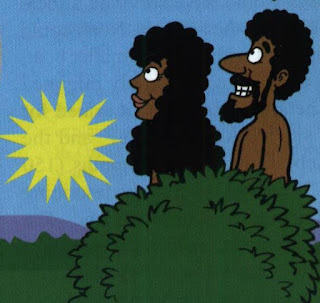THE AGE OF THE EARTH
How old is Planet Earth? This is an important question. In 1862, *Thompson said the earth was 20 million years old. In 1897, he doubled it to 40 million. Two years later, *J. Joly said it was 90 million. *Rayleigh, in 1921, upped it to 1 billion. Eleven years later, *W.O. Hotchkiss moved the figure up to 1.6 billion. *A Holmes in 1947, decided it was 3.35 billion; and, in 1956, raised it to 4.5 billion. Just now, it stands at 5 billion.
But what do scientific facts tell us? They declare that our planet is only a few thousand years old. Here are scientific facts to prove it. This is science vs. evolution—a Creation-Evolution Encyclopedia, brought to you by Creation Science Facts.
INTRODUCTION
How old is our world? This is an important question; even though long ages of time are not a proof of evolution, the evolutionists admit that, without long ages, their peculiar theories could not succeed.
It is theorized that the evolutionary age of the universe is 15 billion years, and the evolutionary age of the earth is 5 billion years.
But, actually, there are many evidences that our own planet is quite young! Here are sixty reasons why our world is not very old!
These are facts which evolutionists do not like to discuss. We can be thankful the evidence is available. In the following study, you will note that different research studies indicate different maximum age lengths for our world. Obviously, the smallest fixed time spans should have precedence. On this basis, our planet appears to have been brought into existence about 6,000 years ago.
EVIDENCE FROM THE STARS
1 - Star clusters. One type of galaxy in outer space is the star cluster. There are many of them; and, within each one, are billions of stars. Some of these clusters are moving so rapidly, that it would be impossible for them to remain together if the universe were very old.—
2 - Large stars. Some stars are so large, and radiate energy so rapidly, that they could not have contained enough hydrogen to radiate at such fast rates for long ages, because their initial mass would have had to be too immense.—
3 - High-energy stars. Four types of stars radiate energy too rapidly to have existed longer than 50,000 to 300,000 years.—
4 - Binary stars. Most stars in the disk of galaxies are binary stars (two stars revolving about one another); yet, frequently, one is classified as very old and the other very young. This cannot be.—.
5 - Hydrogen in the universe. Hydrogen cannot be made by converting other elements into it; therefore, if the universe were as old as the theory requires, there would now be very little hydrogen in the universe.—
EVIDENCE FROM OUR SOLAR SYSTEM
1 - Solar collapse. Our sun is gradually shrinking at a steady rate. It is occurring fast enough that, as little as 50,000 years ago, the sun would have been so large that our oceans would boil. In far less time in the past (25,000 years or so), all life on earth would have ceased to exist.—
2 - Solar neutrinos. The sun is emitting hardly any neutrinos. This, coupled with the fact that the sun is shrinking, points to a recently created sun.—
3 - Comets. Comets circle the sun and are assumed to be as old as our solar system. Since they are continually disintegrating, and a number are known to have broken up, evidently all of them self-destruct within a relatively short time period. It is estimated that the comets cannot be over 10,000 years old.—
4 - Comet water. Comets are primarily composed of water. So many small comets strike the earth that, if our planet was billions of years old, our oceans would be filled several times over with water.—
5 - Solar wind. The sun's radiation blows very small particles in space outward. All particles smaller than a certain size should, millions of years ago, have been blown out of the solar system. Yet these micro-particles are abundant and still orbiting the sun. Therefore our solar system is quite young.—
6 - Solar drag. Small and medium rocks circling the sun are gradually drawn by gravity into the sun. Careful analysis reveals that most would have been gone within 10,000 years, and all within 50,000 years. There is no known source of rock or particle replenishment.—
EVIDENCE FROM THE OTHER PLANETS
1 - Temperature and erosion on Venus. High surface temperatures on Venus (900 degree F [482 degree C]), combined with other of its surface features, support a young age for Venus. If the planet was 4 billion years old, as taught by the theory, its dense atmosphere should long ago have worn away all the craters.—2 - Erosion and water on Mars. Only a few thousand years of the type of harsh dust storm weather occurring on Mars should have seriously eroded its many craters and volcanoes. Long-term erosion should also have obliterated the strong color differences on the surface. The small amount of water on Mars should long ago have been split apart into hydrogen and oxygen by solar ultraviolet rays. The hydrogen should have escaped and the oxygen should be in the atmosphere, but this is not so.—
3 - Composition of Saturn's rings. Trillions of particles in Saturn's rings are mainly solid ammonia. Because of its high vapor pressure, it could not survive long without vaporizing into outer space.—
4 - Bombardment of Saturn's rings. Meteroids bombarding Saturn's rings would have destroyed them in far less than 20,000 years.—
5 - More ring problems. Rings found on Jupiter, Uranus, and Neptune indicate that they too have a very young age.—
6 - Jupiter's moons. One of Jupiter's largest moons, Io, ejects large amounts of material through volcanoes. Although quite small, it has the most active volcanoes we know of, and must be quite youthful.—
EVIDENCE FROM OUR OWN MOON
1 - Moon dust. Ultraviolet light changes moon rocks into dust. It had long been predicted that a thick layer of dust (20-60 miles [32-96.5 km], caused by ultraviolet radiation on the moon's 4-billion-year-old surface, must cover the moon's surface. But scientists were astonished to learn that there is not over 2-3 inches [5.08-7.62 cm] of dust—just the amount expected if the moon was only a few thousand years.—
2 - Lunar soil. The dirt on the moon's surface does not show the amount of soil mixing it should have, if the moon were very old.—p. 17. 3 - Lunar isotopes. Short-term radioactive isotopes (uranium 236 and thorium 230) have been found in the collected moon rocks. These isotopes do not last long and rather quickly turn into lead. If the moon were even 50,000 years old, these short-life radioisotopes would long since have decayed into lead. The moon cannot be older than several thousand years.—
4 - Lunar radioactive heat. Moon rocks have relatively high radioactivity, indicating a young moon, because of the large amount of heat generated.—
5 - Lunar gases. Small amounts of several inert gases have been found on the moon. At today's intensity of solar wind, the amount of inert gases found on the moon would reach their full amount in less than 10,000 years—and no longer.—
6 - Lunar phenomena. Transient lunar activity data (moonquakes, lava flows, gas emissions, etc.) reveals the moon is still remarkably active, showing it is quite young.—
7 - Lunar recession. The moon is already far too close to the earth. It is now know that, due to tidal friction, it is gradually moving farther away from us. Based on the rate of recession, the moon cannot be very old. If it were even 20,000 to 30,000 years old, it would at some earlier time have been so close—it would have fallen into our planet!—
EVIDENCE FROM EARTH'S ATMOSPHERE
1 - Atmospheric helium. Our helium comes from three sources: Radioactive decay of either uranium or thorium produces helium. Helium spewed out by the sun, is pulled in by earth's gravity. Helium is also produced in the upper atmosphere. All of that helium is accumulating, since helium is not able to reach escape velocity and go into outer space. But the amount of helium we have is too small if our world has existed for long ages. Based on all three helium producers, earth's atmospheric age cannot be over 10,000 years.—
2 - Carbon 14 disintegration. The present worldwide buildup of radiocarbon in the atmosphere would have produced all the world's radiocarbon in only several thousand years. Based on this, earth's age is estimated at 8,000 years.—
EVIDENCE FROM METEORITES
1 - Meteor dust. Micrometeors, composed of iron, nickel, and silicate compounds that are continually entering our atmosphere, adds 25 tons [22.7 mt] to the earth daily. Based on the amount here, earth's age should be in the thousands, not millions of years. Regarding nickel content, the amount in the oceans could have been carried there from land in 9,000 years (or half that time, if nickel had already been there).—
2 - Meteor craters. Meteor craters are never found in the rock strata! Yet they would be found there, if millions of years were required to lay down that sedimentary strata. Meteor craters always lie close to or on the earth's surface. Thus, all the meteors which have struck the earth—have hit it within the last few thousand years.—
3 - Meteor rocks. When meteors strike the earth, they are called meteorites. Supposedly, this has happened for millions of years, yet the meteorites are only found at, or close to, the earth's surface. None are ever found in the deeper sedimentary strata. Therefore, the earth is young and the strata was quickly laid down not too long ago.
4 - Tektites. Tektites are a special type of glassy meteorite. They are especially found in large areas, called strewn fields. Each shower lies on the surface or in the topmost layers of soil; they are never found in the sedimentary fossil-bearing strata. If the earth were billions of years old, they should be found in all the strata. They never show more than a few thousand years of weathering. Carbon-14 tests show them to be no older than 6,500 years.—




Comments
Post a Comment